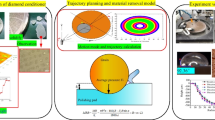Abstract
Chemical mechanical polishing (CMP) performance is often determined by the pad surface texture, which is mainly controlled by using a pad conditioner: usually, a diamond disk comprising numerous diamond grits attached to a flat metal substrate by means of brazing with an alloy. During the conditioning process, the diamonds interact with the pad surface to mainly remove the glazed layer and restore pad asperities. Selection of the appropriate diamond shape is crucial for obtaining the desired pad properties, conditioner life, and wafer removal rate. In this investigation, three different diamond shapes were carefully fabricated: (1) “sharp,” a sharp-edged diamond; (2) “blocky,” a high-quality crystalline diamond; and (3) “mixed,” a combination of sharp and blocky diamonds. Three new disks were fabricated using the above mentioned diamond shapes. Pad surface characterization was carried out to compare the new disks with conventional diamond disks, and the effect of the diamond shape on the wafer removal rate was studied. Oxide CMP tests revealed that the “mixed” diamond grit provided the highest wafer removal rate and the best uniformity. As compared to a conventional diamond disk, it also achieved a higher wafer removal rate and a better uniformity while consuming less pad material. On the other hand, if the dressing stability is the major concern, the use of “blocky” diamond grit is recommended because it provided the most stable wafer removal rate over a conditioning time of up to 20 h. However, if the dressing capability is the major concern, the use of “sharp” diamond grit is suggested because it provided the highest pad cut rate.
Similar content being viewed by others
References
Steigerwald JM, Murarka SP, Gutmann RJ (1997) Chemical mechanical planarization of microelectronic materials. Wiley, New York
Liao HT, Shie JR, Yang YK (2008) Application of Taguchi and design of experiments methods in optimization of chemical mechanical polishing process parameters. Int J Adv Manuf Technol 38:674–682
Hooper B-J, Byrne G, Galligan S (2002) Pad conditioning in chemical mechanical polishing. J Mater Process Technol 123:107–113
Achuthan K, Curry J, Lacy M, Campbell D, Babu SV (1996) Investigation of pad deformation and conditioning during the CMP of silicon dioxide films. J Electron Mater 25:10–16
Stein D, Hetherington D, Dugger M, Stout T (1996) Optical interferometry for surface measurements of CMP pads. J Electron Mater 25:1623–1627
Zimmer J, Stubbmann A, (1998) A key factors influencing performance consistency of CMP pad conditioners. Third International CMP-MIC Conference, Santa Clara, USA, February, pp 87–92
Baker R (1997) Conditioning for Removal Rate Stability. Second International CMP-MIC Conference, Santa Clara, USA, February, pp 339–342
Chang SH, Jeng W (1998) Optimization of Pad Conditioning Disk in CMP. Third International CMP-MIC Conference, Santa Clara, USA, February, pp 523–526
Sung J, Pai YL (2000) CMP pad dresser: A diamond grid solution, In Advances in Abrasive Technology III 189–196, Soc. of Grinding Engineers, USA, pp
Garretson CC, Mear ST, Rudd JP, Prabhu G, Osterheld T, Flynn D (2000) New Pad Conditioning Disk Design Delivers Excellent Process Performance While Increasing CMP Productivity. Fifth International CMP-MIC Conference, Santa Clara, USA, February, pp N1–N5
Rikita N, Shimizu A, Kobayashi H (2008) The use of Tagichi to CMP conditioner. International Conference on Planarization/CMP Technology, Taiwan, pp 97–104
Chen K-R, Young H-T (2009) Estimation of dressing effects in chemical mechanical polishing with sorts of diamond dressers. Adv Mater Res 76–78:175–180
Tsai MY, Chen ST, Liao YS, Sung JC (2009) Dressing characteristics of CMP polishing pad using a novel diamond conditioner. Int J Mach Tool Manuf 49:922–729
Yeh HM, Chen KS (2010) Development of a pad conditioning simulation module with a diamond dresser for CMP application. Int J Adv Manuf Technol 50:1–12
Tso PL, Ho SY (2007) Factors influencing the dressing rate of chemical mechanical polishing pad conditioning. Int J Adv Manuf Technol 123:107–113
Tso PL, Hsu R (2007) Estimating chemical mechanical polishing pad wear with compressibility. Int J Adv Manuf Technol 32:682–689
Sung JC, Chen NL, Pai YL, Chou C-S, Chou C-C (2009) The Pad Dressing Phenomena of Multiple Diamond Grits: Implication for The Design of CMP Pad Conditioners. Second International Conference on Planarization/CMP Technology, Japan, Fukuoka, November pp 19–21
Tsai MY, Liao YS (2009) Dressing characteristics of oriented single diamond on CMP polyurethane pad. Mach Sci Technol 13:92–105
Lee H, Joo S, Jeong H (2009) Mechanical effect of colloidal silica in copper chemical mechanical planarization. J Mater Process Technol 209:6134–6139
Lee H, Zhuang Y, Sugiyama M, Seike Y, Takaoka M, Miyachi K, Nishiguchi T (2010) Pad flattening ratio, coefficient of friction and removal rate and analysis during silicon dioxide chemical mechanical planarization. Thin Solid Films 518:1994–2000
Kim H, Jeong H, Lee E, Shin Y (2004) Pad surface characterization and its effect on the tribological state in chemical mechanical polishing. Key Eng Mater 283–388
Stein D, Dugger DM, Stout T (1996) Optical interferometry for surface measurements of CMP pads. J Electron Mater 25:1623–1627
Kawakubo M, Kadomura K, Sugaya T, Hirai O, Tsugane K, Tamada Y (2009) Effect of mechanical and chemical wear of diamond consistency of conditioning, Second International conference on planarization/CMP Technology, Japan, Fukuoka, November pp 313–318
Author information
Authors and Affiliations
Corresponding author
Rights and permissions
About this article
Cite this article
Tsai, M.Y., Chen, W.K. Effect of CMP conditioner diamond shape on pad topography and oxide wafer performances. Int J Adv Manuf Technol 55, 253–262 (2011). https://doi.org/10.1007/s00170-010-3055-y
Received:
Accepted:
Published:
Issue Date:
DOI: https://doi.org/10.1007/s00170-010-3055-y



